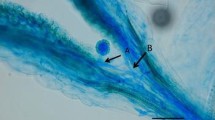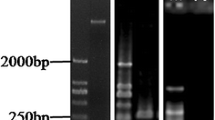Abstract
The influence of self-incompatibility (SI) on fruit set, seed set, and pollen tube growth was investigated in Schlumbergera truncata (Haworth) Moran and S.xbuckleyi (T. Moore) Tjaden. Four Schlumbergera clones were crossed in a complete diallel to verify the presence of SI. Fruit did not set when the clones were selfed or when two of the clones were crossed reciprocally, but all other outcrosses yielded fruit which contained ≈100–200 seeds each. Compatible outcrosses were characterized by large numbers of pollen tubes in the style and ovary cavity at 72 h after pollination. When pistils were selfed or incompatibly crossed, pollen tubes were inhibited in the upper third of the style and few pollen tubes reached the base of the style by 72 h after pollination. Schlumbergera exhibits several characteristics often associated with sporophytic SI systems (tricellular pollen and dry stigmas with elongate papillae), together with those commonly observed in gametophytic SI systems (stylar inhibition of incompatible pollen tubes and absence of reciprocal differences in outcrosses).
Similar content being viewed by others
References
Abendroth A (1969) Pollination and fruits of S. truncata. Epiphytes 2:35–36
Baker HG, Baker I (1983) Some evolutionary and taxonomic implications of variation in the chemical reserves of pollen. In: Mulcahy DM, Ottaviano E (eds) Pollen: biology and implications for plant breeding. Elsevier Biomedical, New York, pp 43–52
Barthlott W (1988) Über die systematischen Gliederungen der Cactaceae. Beitr Biol Pflanz 63:17–40
Barthlott W, Rauh W (1975) Notes on the morphology, palynology, and evolution of the genus Schlumbergera Lemaire (Cactaceae). Cactus Succulent J [Suppl] 47:5–21
Barthlott W, Rauh W (1977) Die Wildarten und Hybriden der Weihnachtskakteen (Gattung Schlumbergera). Kakteen Sukkulenten 28:273–278
Boyle TH (1994) A simple method for extracting and cleaning seeds of Rhipsalidopsis and Schlumbergera (Cactaceae). HortTechnology 4:264–265
Boyle TH, Menalled FD, O'Leary MC (1994) The occurrence and physiological breakdown of self-incompatibility in Easter cactus. J Am Soc Hort Sci 119:1060–1067
Boyle TH, Karle R, Han SS (1995) Pollen germination, pollen tube growth, fruit set, and seed development in Schlumbergera truncata and S.xbuckleyi (Cactaceae). J Am Soc Hort Sci 120:313–317
Breckenridge FG, Miller JM (1982) Pollination biology, distribution, and chemotaxonomy of the Echinocereus enneacanthus complex. Syst Bot 7:365–378
Brewbaker JL (1957) Pollen cytology and self-incompatibility systems in plants. J Hered 48:271–277
Brewbaker JL (1959) Biology of the angiosperm pollen grain. Indian J Genet Plant Breed 19:121–133
Buxbaum F (1953) Morphology of cacti. II. The flower. Abbey Garden Press, Pasadena, Calif
Cobia ME (1992) Zygocactus (Schlumbergera): a comprehensive guide for the weekend gardener. Tillington House, Coffs Harbor, New South Wales
East EM (1940) The distribution of self-sterility in flowering plants. Proc Am Philos Soc 82:449–518
Fryxell PA (1957) Mode of reproduction of higher plants. Bot Rev 23:135–233
Ganders FR (1976) Self-incompatibility in the Cactaceae. Cactus Succulent J 38:39–40
Grant V, Grant KA, Hurt PD Jr (1979) Pollination of Opuntia lindheimeri and related species. Plant Syst Evol 132:313–320
Hansson J (1992) Our way of growing Christmas cacti (Schlumbergera). Inst Quebec Dev Hort Ornement Bull S-4:21–27
Heslop-Harrison J, Heslop-Harrison Y (1970) Evaluation of pollen viability by enzymatically induced fluorescence; intracellular hydrolysis of fluorescein diacetate. Stain Technol 45:115–120
Horobin JF, McMillan AJS (1985) Schlumbergeraxreginae: a new Schlumbergera hybrid. Br Cactus Succulent J 3:12–13
Hunt DR (1969) A synopsis of Schlumbergera Lem. (Cactaceae). Kew Bull 23:255–263
Hunt DR (1981) Schlumbergeraxbuckleyi. Curtis's Bot Mag [New Ser] 183:119–122
Lambert S (1985) Variable self-compatibility in Neolloydia intertexta (Cactaceae). Plant Syst Evol 148:287–289
Leuenberger BE (1986) Pereskia (Cataceae). Memoirs New York Botanical Garden 41:1–141
Martin FW (1959) Staining and observing pollen tubes in the style by means of fluorescence. Stain Technol 34:125–128
McGregor SE, Alcorn SM, Olin G (1962) Pollination and pollinating agents of the saguaro. Ecology 43:259–267
McMillan AJS (1985) Christmas cacti. Urs Eggli, Switzerland
McMillan AJS (1991) Mountain cacti of Brazil. Br Cactus Succulent J 9:46–47
Murawski DA, Fleming TH, Ritland K, Hamrick JL (1994) Mating system of Pachycereus pringlei: an autotetraploid cactus. Heredity 72:86–94
Nettancourt D de (1977) Incompatibility in angiosperms. (Monographs on theoretical and applied genetics, vol 3) Springer, Berlin Heidelberg New York
Ross R (1981) Chromosome counts, cytology, and reproduction in the Cactaceae. Am J Bot 68:463–470
Tjaden WL (1966) Schlumbergera (Lem.) Moran. Natl Cactus Succulent J 21:84–86, 91–93
Weiss J, Nerd A, Mizrahi Y (1993) Development of Cereus peruvianus (apple cactus) as a new crop for the Negev desert of Israel. In Janick J, Simon JE (eds) New crops. Wiley, New York, pp 486–491
Author information
Authors and Affiliations
Additional information
Publication no. 3174 of the Massachusetts Agricultural Experiment Station
Rights and permissions
About this article
Cite this article
Boyle, T.H. Characteristics of self-incompatibility in Schlumbergera truncata and S. x buckleyi (Cactaceae). Sexual Plant Reprod 9, 49–53 (1996). https://doi.org/10.1007/BF00230366
Received:
Accepted:
Issue Date:
DOI: https://doi.org/10.1007/BF00230366




